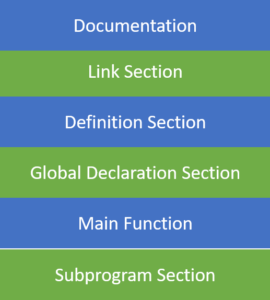Full Stack Development Internship Program
- 29k Enrolled Learners
- Weekend/Weekday
- Live Class
In this article, we are going to learn about the basic structure of a C program. A C program is divided into different sections. There are six main sections to a basic c program.
The six sections are,
So now that the introduction is out of the way, let us jump to the main discussion. The whole code follows this outline. Each code has a similar outline. Now let us learn about each of this layer in detail.

Moving on to the next bit of this basic structure of a C program article,
Related Learning: How to Run a C Program in Command Prompt?
The documentation section is the part of the program where the programmer gives the details associated with the program. He usually gives the name of the program, the details of the author and other details like the time of coding and description. It gives anyone reading the code the overview of the code.
Example
/**
* File Name: Helloworld.c
* Author: Manthan Naik
* date: 09/08/2019
* description: a program to display hello world
* no input needed
*/
Moving on to the next bit of this basic structure of a C program article,
This part of the code is used to declare all the header files that will be used in the program. This leads to the compiler being told to link the header files to the system libraries.
Example
#include<stdio.h>
Moving on to the next bit of this basic structure of a C program article,
In this section, we define different constants. The keyword define is used in this part.
#define PI=3.14
Moving on to the next bit of this basic structure of a C program article,
This part of the code is the part where the global variables are declared. All the global variable used are declared in this part. The user-defined functions are also declared in this part of the code.
float area(float r); int a=7;
Moving on to the next bit of this basic structure of a C program article,
Every C-programs needs to have the main function. Each main function contains 2 parts. A declaration part and an Execution part. The declaration part is the part where all the variables are declared. The execution part begins with the curly brackets and ends with the curly close bracket. Both the declaration and execution part are inside the curly braces.
int main(void)
{
int a=10;
printf(" %d", a);
return 0;
}
Moving on to the next bit of this basic structure of a C program article,
All the user-defined functions are defined in this section of the program.
int add(int a, int b)
{
return a+b;
}
The C program here will find the area of a circle using a user-defined function and a global variable pi holding the value of pi
* File Name: areaofcircle.c
* Author: Manthan Naik
* date: 09/08/2019
* description: a program to calculate area of circle
*user enters the radius
**/
#include<stdio.h>//link section
#define pi 3.14;//defination section
float area(float r);//global declaration
int main()//main function
{
float r;
printf(" Enter the radius:n");
scanf("%f",&r);
printf("the area is: %f",area(r));
return 0;
}
float area(float r)
{
return pi * r * r;//sub program
}
Output

This is all about the basic structure of a C program. I hope you found this article informative and helpful, stay tuned for more tutorials on similar topics.You may also checkout our training programs, you can enroll here for live online training with 24/7 support and lifetime access.
Got a question for us? Mention them in the comments section and we will get back to you